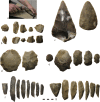Stone toolmaking difficulty and the evolution of hominin technological skills
- PMID: 35393496
- PMCID: PMC8989887
- DOI: 10.1038/s41598-022-09914-2
Stone toolmaking difficulty and the evolution of hominin technological skills
Abstract
Stone tools are a manifestation of the complex cognitive and dexterous skills of our hominin ancestors. As such, much research has been devoted to understanding the skill requirements of individual lithic technologies. Yet, comparing skill across different technologies, and thus across the vast timespan of the Palaeolithic, is an elusive goal. We seek to quantify a series of commensurable metrics of knapping skill across four different lithic technologies (discoids, handaxes, Levallois, and prismatic blades). To compare the requisite dexterity, coordination, and care involved in each technology, we analysed video footage and lithic material from a series of replicative knapping experiments to quantify deliberation (strike time), precision (platform area), intricacy (flake size relative to core size), and success (relative blank length). According to these four metrics, discoidal knapping appears to be easiest among the sample. Levallois knapping involved an intricate reduction sequence, but did not require as much motor control as handaxes and especially prismatic blades. Compared with the other Palaeolithic technologies, we conclude that prismatic blade knapping is set apart by being a skill intensive means of producing numerous standardised elongate end-products.
© 2022. The Author(s).
Conflict of interest statement
The authors declare no competing interests.
Figures



References
-
- Muller A, Clarkson C, Shipton C. Measuring behavioural and cognitive complexity in lithic technology throughout human evolution. J. Anthropol. Archaeol. 2017;48:166–180. doi: 10.1016/j.jaa.2017.07.006. - DOI
-
- Mellars P. Major issues in the emergence of modern humans. Curr. Anthropol. 1989;30:349–385. doi: 10.1086/203755. - DOI
-
- Mellars P. Technological changes across the Middle-Upper Palaeolithic transition: Economic, social and cognitive perspectives. In: Mellars P, Stringer C, editors. The Human Revolution: Behavioural and Biological Perspectives on the Origins of Modern Humans. Edinburgh University Press; 1989. pp. 338–365.
-
- Foley R. Hominid species and stone-tool assemblages: How are they related? Antiquity. 1987;61:380–392. doi: 10.1017/S0003598X00072938. - DOI
Publication types
MeSH terms
LinkOut - more resources
Full Text Sources
Research Materials

